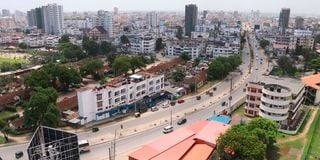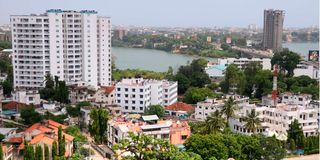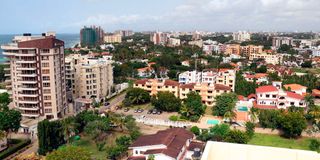Premium
Mombasa’s changing skyline a threat to its heritage status

New commercial and residential highrise buildings tower over old houses in Tonnoka area of Mombasa County.
What you need to know:
- Homeowners forced to sell as neighbouring tall buildings obscure light, take away privacy.
- County official insists that all the buildings coming up are following the devolved unit’s zoning guidelines.
The city of Mombasa is Kenya’s top tourism hub due to its proximity to the Indian Ocean, sandy beaches and a unique multicultural — including Arab, Portuguese, Asian and British — architecture.
A majority of the current residents of Old Town in the city are of Asian, Arab and European descent, and the architectural styles of the buildings in the area reflect these cultures.

Highrise buildings in Tudor area of Mombasa County.
However, in recent days, this attraction has been diminishing, thanks to emerging multi-million real estate investments that not only damage the area’s heritage status, but also threaten the lives of the inhabitants of the ancient buildings.
Old Town, which used to attract tourists for its rich Swahili culture, is now losing its glory thanks to exponential growth of high-rise apartments.
With limited horizontal space, real estate investors are now utilising vertical space, with the devolved unit still keen to ensure that the structures are up to standard.
Developers are squeezing high-rise buildings, some as high as 15 stories, between Swahili buildings, with Majengo, Ganjoni and Tudor having most of these new buildings.

Highrise buildings in Tudor area of Mombasa County.
Kizingo, a wealthy suburb, has also experienced high-rise buildings offering ocean views to its high-end clientele. Some buildings, such as Kizingo Towers, rise to 81.44 metres above sea level. Jaffery Complex in Ganjoni, a 20-storey skyscraper, rises to 79 meters above sea level and houses three- and four-bedroom houses.
“I had to sell my Swahili house after it was surrounded by five tall buildings. The fresh air that I enjoyed for more than 30 years in my house diminished and my lights had to stay on all day as the house was dark,” said Ismail Karani, a former Majengo resident who has since moved to Changamwe.
Mombasa County executive committee member for Lands, Planning and Housing Mohamed Hussein denied that Mombasa will lose its culture, saying there are zoning rules that do not allow some types of houses to be built.
“In a place like Old Town, we do not expect such houses to be demolished and replaced by high-rise buildings. The area is protected to preserve our culture,” said Mr Hussein.

Mombasa County executive committee member for Lands, Planning and Housing Mohamed Hussein during an interview with the Nation in Mombasa.
He added that the houses being built must comply with county planning requirements, and to cope with the growing population, all houses must have a biodigester to support the already overburdened sewage system.
“The population is growing, which has forced developers to build apartments in Mombasa due to limited space, but we are doing this within the law and no building will be constructed without complying with the law,” said Mr Hussein.
He added: “On the issue of water to serve the growing population, we are happy to have more supply from Marereni and other water projects like the Mwache dam which is underway.”
The transformation is also taking place in the Nyali suburb, where developers are squeezing high-rise buildings, some as high as 10 stories, in between mansions.

An aerial view of a section of Nyali area in Mombasa County with high-rise buildings.
This means that a bungalow owner sunbathing by his swimming pool has no privacy as residents of a towering apartment building can see everything.
Homeowners have been forced to sell and relocate to Vipingo or Bofa in Kilifi, which are less crowded.





